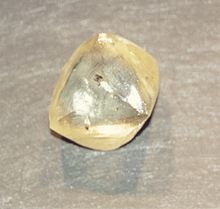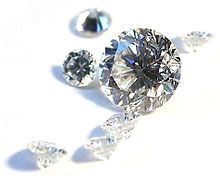- Diamonds as an investment
-
Contents
History
Diamonds have been treasured as gemstones since the ancient times[citation needed]. Popularity of diamonds has risen since the 19th century because of successful advertising in spite of a greatly increased supply. Diamonds are not normally used as a mainline store of value during times of crisis, because of their lack of fungibility and low liquidity. However, they may still be useful during times of hyperinflation.
Approximately 20% of mined diamonds are used in jewelry and 80% for industrial uses (such as lasers, drill parts and surgical equipment).
Chemical vapor deposition is now used to produce synthetic diamonds which, unlike diamond simulants, inherit all the properties of gemstones formed in nature.
Price fluctuations
Historically, the rough diamond price has been controlled by the De Beers Group, which has a 40% to 50% market share.[1] Botswana is currently the largest producer of diamonds by value, with mines operated by Debswana, a joint venture between De Beers and the government of Botswana.[2] However, since the 1980s, other producers have developed new mines in Russia, Canada and Australia for example, challenging De Beers' dominance (historically De Beers' market share was considerably higher). De Beers through its trading company DTC raised wholesale diamond prices three times in 2004 by a total of 14%.[citation needed]
The United States is the biggest consumer of diamonds in the world. It accounts for 35% of diamond sales, Hong Kong 26%, Belgium 15%, Japan 6%, and Israel 4%.[3][dead link] Israel and Belgium in particular are important diamond-trading hubs thus their consumption numbers are misleading.
Polished diamond prices vary widely depending on a diamond's carat, color, clarity and cut (The 4 C's). In contrast to precious metals, there is no universal world price per gram for diamonds. However the industry does refer to price guides such as the Rapaport Diamond Report, The Diamond Registry Wholesale Diamond Price List,[4] Ajediam Antwerp Diamonds Monthly[5] and The Gem Guide, which are published weekly or quarterly.
In addition to print and online references, numerous institutions have varying standards which can be used to aid in diamond identification and pricing. GIA,[6] HRD[7] and IGI[8] are three such institutions. Often these organizations focus on new research and education which they pass on to their members and the public.
Financial feasibility
There is no natural shortage of diamonds. Diamonds can be synthesized at much lower cost than the equivalent natural diamond price,[citation needed] and the chemical and structural purity of a synthetic diamond can exceed a natural one. However, the chemical composition is not the only factor that determines their value - the quality of the cut is of as much, if not greater, importance.
Today there are a few funds that are investing in diamonds. These funds purchase unique diamonds (very large in size or color); each stone is checked by a few professionals and negotiated until the fund decides to purchase it. Then a marketing team goes into action and through an extensive work the fund yield is gained. Between 2007 and 2008 the price of a diamond from the top range of color, clarity, cut and carat went up by over 50%.[citation needed]
Investment vehicles
Polished diamonds
Polished and rough diamonds lack some of the desirable attributes of investment vehicles, including liquidity, homogeneity and fungibility. Grading and certification by recognised laboratories goes some way to redressing this. Weight and cutting proportions are parameters which can be precisely measured. Colour and clarity grades are parameters which need to be determined by gemologists.
The increasing quality and size, and decreasing price, of synthetic diamonds is presented as a threat to the value of polished diamonds as a long-term investment, but has never impacted real investment-grade diamond prices. The possibility of low-cost ultra–high-quality diamonds becoming available in industrial quantities at some time in the future has never been a hindrance for long-term investors in diamonds; synthetic diamonds have been manufactured since the 1950s[9] and have yet to make a major impact on the market.
An alternative example of such a price fall caused by introduction of a new simulant strongly undermining prices was the permanent fall in natural pearl prices with the introduction of cultured pearls. The mechanism by which prices were affected was complex. In part because of the social acceptability of wearing cultured pearls to much of the market, customers migrated from the natural to the lower priced cultured product. This altered the supply and demand situation for natural pearls and perhaps the overall prestige of pearls in general was lowered. In cases where synthetic stones have been much less socially acceptable to the market as a replacement for the natural version, the prestige of the natural stones has been retained. Thus increased availability and lowered prices of synthetics may or may not have major implications for the future price of natural diamonds. In addition, the introduction of synthetic rubies in the late 19th Century did not appear to have a permanent effect on the price of natural rubies.
There are several factors contributing to low liquidity of diamonds. One of the main is the lack of terminal market. Most commodities have terminal markets, and some form of commodities exchange, clearing house, and central storage facilities. Until recently this did not exist for diamonds. Diamonds are also subject to value added tax in the UK, EU, and sales tax in most developed countries, therefore reducing their effectiveness as an investment medium. Most diamonds are sold through retail stores at very high profit margins.
As diamonds in larger sizes become increasingly rare and valuable, any easily visible and readily understood pricing system has been difficult to establish. Martin Rapaport produces the Rapaport Diamond Report, which lists prices for polished diamonds. The Rapaport Diamond Report is relatively expensive to subscribe to, and as such is not readily available to consumers and investors. Each week, there are matrices of diamond prices for round brilliant cut diamonds, by colour and clarity within size bands, and also other shapes. The price matrix for brilliant cuts alone exceeds 1,400 entries, and even this is achieved only by grouping some grades together. There are considerable price shifts near the edges of the size bands, so a 0.49 carats (98 mg) stone may list at $5,500 per carat = $2,695, while a 0.50 carats (100 mg) stone of similar quality lists at $7,500 per carat = $3,750. This may appear such a large difference as to defy logic, but in reality stones near the top of a size band (or rarer fancy coloured varieties) tend to be uprated slightly. Some of the price jumps are related to marketing and consumer expectations. For example, a buyer expecting a 1 carat (200 mg) diamond solitaire engagement ring may be unprepared to accept a 0.99 carats (198 mg) diamond.
There are numerous diamond grading laboratories, with each offering investors, consumers and dealers similar diamond-grading and verification services. The standards are high, and when they ever slip, immediate ramifications are felt throughout the diamond industry. When the market-leading Gemological Institute of America (GIA) saw a number of large, important and valuable diamonds overgraded some time ago, this resulted in legal action by one dealer against another dealer who had submitted them to the GIA for grading. A number of GIA employees left after the scandal emerged, and the GIA immediately changed a number of its procedures to prevent such occurrences from happening again. There are also a number of laboratories affiliated to CIBJO (Confédération Internationale de la Bijouterie, Joaillerie et Orfèvrerie, also known as the World Jewellery Confederation).
The non-linear, exponential pricing of different sizes (weights) of diamonds means that it is not realistic to exchange, for example, 2 quarter carats (50 mg) for 1 half carat (100 mg). With commodities such as gold, it is clear that 1 twenty gram bar is worth the same as 2 ten gram bars, assuming the same quality. In most terminal markets, there needs to be a readily available standard quality, or limited number of qualities, available in sufficient quantity to be tradable. This is a major factor which affects liquidity. The large number of variables in diamond quality makes commodity-like pricing difficult, especially with rarer stones that merit special handling above standard-issue diamonds.
There are also fashion and marketing elements to take into consideration. De Beers expends marketing efforts to encourage sales of diamond sizes and qualities which are being produced in relatively large quantities. They have also been known to take steps to discourage investment, primarily because they perceive that bubble prices which are followed by sharp falls are bad for long term consumer confidence in diamonds as a long-term store of value.[citation needed].
The investment parameter of diamonds is their high value per unit weight, which makes them easy to store and transport. A high quality diamond weighing as little as 2 or 3 grams could be worth as much as 100 kilos of gold. This extremely condensed value and portability does bestow diamonds as a form of emergency funding. People and populations displaced by war or extreme upheaval have utilised this portable asset successfully.[citation needed] In 2009 an exchange was launched by DODAQ to trade categories of polished diamonds. The DODAQ exchange is intended to be a terminal market for round polished certified diamonds (which is the most liquid part of the market) and hosts its centralised storage facility in a Freezone. The exchange is an attempt to overcome the traditional investment barriers of sales tax and low liquidity on the resale market.
Funds
In 2008 Diapason Commodities Management listed an investment company called Diamond Circle Capital, which aimed to invest in rare colored and colorless diamonds worth more than $1m each. As of July 2008 the IPO for the closed-end fund was postponed until further notice.[1]
Mining companies
See also: Category:Diamond mining companiesThese do not represent diamonds at all, but rather are shares in companies that mine diamonds. Rockwell Diamonds, located in South Africa, which is also listed on Toronto Stock Exchange, is an example of a mid-tier established diamond producer.
The largest diamond company in the world is Alrosa, which surpassed De Beers in carat production in 2008.[10] Alrosa is currently government owned, so not listed on the stock market. De Beers is privately owned by Anglo American (45%), the Oppenheimer family (40%) and the Botswana government (15%), so its shares are not traded on the stock market.[11] Rio Tinto and BHP Billiton are the next largest producers, but diamond mining is a small part of their commodity portfolio.
Taxation
European Union
Diamonds are subject to value added tax, and sales tax in most developed countries. Other taxes such as capital gains tax may apply for individuals depending on citizenship and if the asset is sold at increased value. Rough diamonds are also subject to taxation and in the near future all rough diamonds mined in South Africa will be subject to a 7% royalty.
See also
- Blood diamond
- Gold as an investment
- Palladium as an investment
- Silver as an investment
- Platinum as an investment
References
- ^ Europa Press Release, Competition: De Beers’ commitment to phase out rough diamond purchases from ALROSA, 22 February 2006
- ^ Kimberley Process Statistics website
- ^ Diamonds are big in the North, Northern News Services online, 2003
- ^ The Diamond Registry, Diamond Registry Wholesale Diamond Prices
- ^ Ajediam, Antwerp World Diamond Center Prices Ratings
- ^ GIA - Gemological Institute of America
- ^ HRD - Hoge Raad Diamant (High Diamond Council)
- ^ IGI - International Gemological Institute
- ^ Gary Roskin, Gem-quality synthetic diamond, JCK Online, 2/1/2004
- ^ http://www.ft.com/cms/s/0/59dba1ea-0ba1-11e0-a313-00144feabdc0.html#axzz1ALqAFBh7 Russia's Alrosa shaping up for flotation
- ^ http://news.bbc.co.uk/2/hi/business/1337637.stm
- Have You Ever Tried to Sell a Diamond? - The Atlantic Monthly February 1982
- Epstein, Edward Jay (1982). "THE DIAMOND INVENTION" (Complete book, includes "Chapter 20: Have you ever tried to sell a diamond?")
External links
Categories:- Diamond
- Commodities used as an investment
Wikimedia Foundation. 2010.


